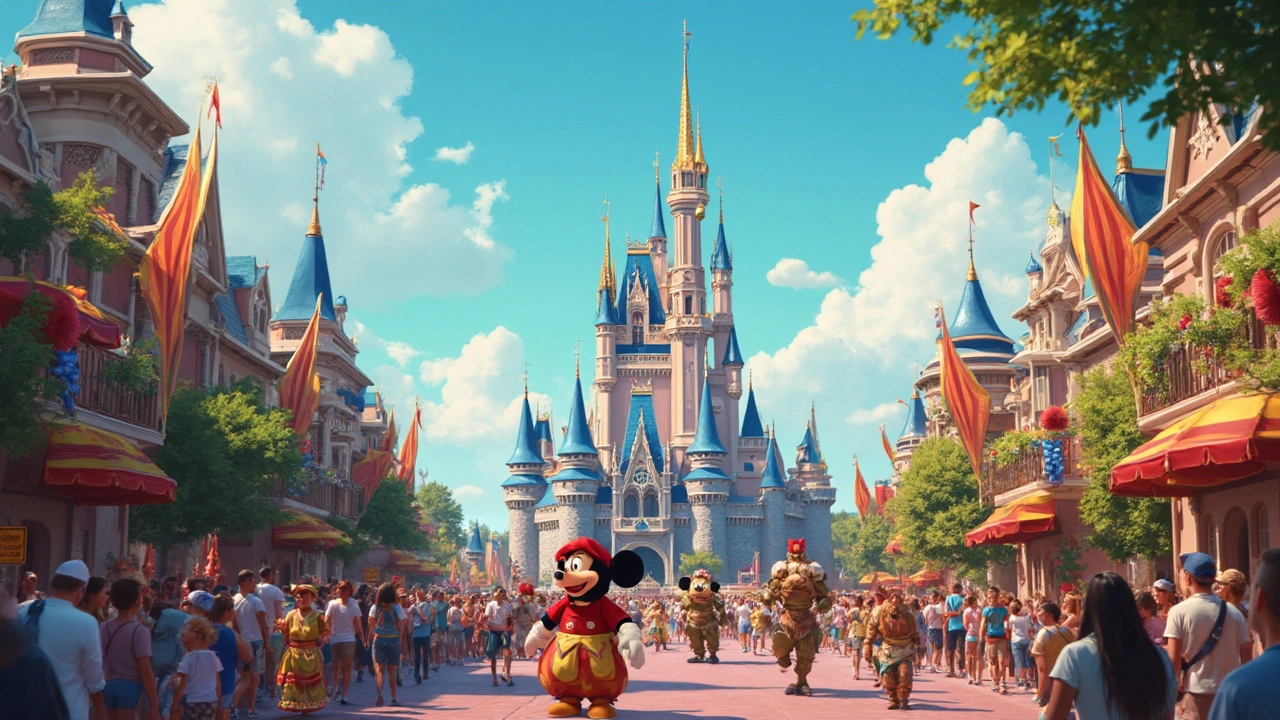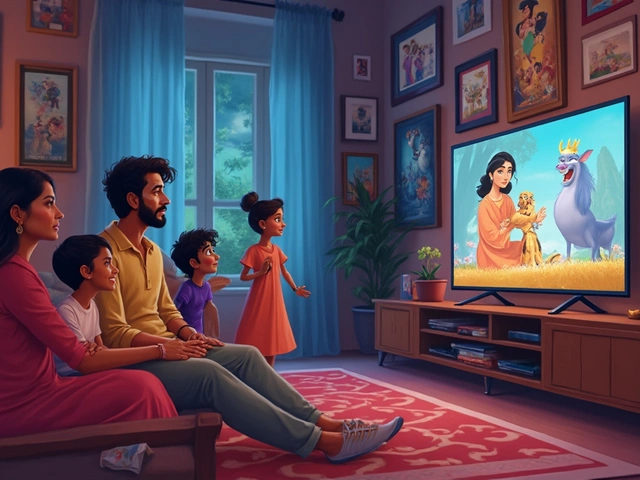So, how deep in the red is Disney these days? As of early 2025, Disney's debt is creeping into the realm of billions. It's a startling number, but there's a lot more to it than meets the eye.
Ever wonder why such a successful movie-making giant has so much debt? Well, running an empire full of beloved characters and theme park wonderlands ain't cheap. Disney takes on debt for a bunch of reasons, like expanding its kingdom through buying up brands or making sure its latest films are big enough to fill cinemas.
The pandemic didn't do Disney any favors either. With theme parks closed and moviegoers chilling at home, the money situation got a bit tricky. But don't think for a second they're sitting back. Disney's been busy trying to manage this debt while keeping the magic alive for fans around the world.
Curious to see how all this impacts the box office collections? Stick around as we unravel how debt affects Disney's ability to bring blockbuster magic to the screens.
- Disney's Current Debt Overview
- Impacts of the Pandemic
- Box Office Hits and Misses
- Why Disney Takes on Debt
- How Disney Plans to Manage Debt
- What This Means for Movie Lovers
Disney's Current Debt Overview
Diving into Disney’s financials is like peeking behind the curtain of a magic show. While the front looks dazzling, the backstage is all about numbers and balancing acts. Right now, Disney is juggling quite a bit — over $50 billion in debt. Yeah, you read that right. That’s a lot of zeroes for a company known for turning mice into princes and sea creatures into songbirds.
So, what’s all this Disney debt for, you ask? Essentially, Disney has taken on these financial obligations to fuel its growth and keep us entertained. From purchasing assets like Fox, which was a whopping $71 billion deal, to pouring cash into Disney+ to keep up in the streaming wars, the money has to come from somewhere.
Let's break it down further. Here's an idea of where their bucks are tied up:
- Acquisitions: Buying companies like Marvel and Lucasfilm didn’t come cheap, but the returns from blockbuster hits have been worth the investment.
- Theme Parks: Expanding and updating parks worldwide needs a ton of capital. Who thought castles and roller coasters could cost so much?
- Streaming Services: Pumping money into producing original content and expanding Disney+ is a big part of their strategy.
And how's Disney planning to manage this mountain of debt? They're working on paying it down gently, counting heavily on revenues from big blockbuster releases and theme park visitors finally returning.
Here's a quirky look at some of Disney's debt numbers:
| Category | Amount (in billions) |
|---|---|
| Syndicated Loan | $5.25 |
| Bond Issuance | $11.5 |
| Bank Borrowings | $4.2 |
The neat thing about Disney is their knack for managing these complex layers of obligations while still being able to produce magic on screen. The coming years will tell if this gamble pays off and how much box office collections will play a part in lightening their debt load.
Impacts of the Pandemic
When the pandemic hit, it was as if someone pressed pause on the world, and Disney was definitely caught in the freeze frame. Between shuttered theme parks and movie theaters going dark, the once bustling streams of pixie dust hit a brick wall. All those empty seats meant empty cash registers.
During the height of the pandemic, Disney reported billions in losses. With travel restrictions and health concerns, their parks—which are usually a cash cow—saw visitor numbers drop like a stone. This was a real kick because theme parks are a huge part of keeping Disney's finances buoyant.
Movies didn't fare much better. The straight-to-stream approach might have saved some face, but missing out on big-screen releases meant missing those juicy box office numbers. It's not quite the same watching the latest blockbuster from your couch, is it?
Thanks to all this chaos, Disney's debt levels climbed. They had to borrow more to keep the engines running, covering operating costs and waiting for the world to return to some kind of normal. Not forgetting the high costs of maintaining their new projects and acquisitions, Disney needed funds to stay afloat.
Recovery was slow, with gradual reopenings and safety protocols stretching budgets, but Disney's been working hard on regaining ground. As the world started to open up, Disney bounced back with fresh content and innovative strategies to attract audiences back to theaters and parks, hoping to turn their financial rollercoaster into a steady ride.
Disney debt is still a big talking point, especially when thinking about the future of its box office collections. Is the magic going to be enough to overcome these hurdles? Only time will tell, as they continue to navigate the challenges left in the pandemic's wake.
Box Office Hits and Misses
Disney's known for creating films that get everyone talking, from kids to grandparents. But not every movie's a billion-dollar winner. Let's take a look at some of their recent box office hits and misses, shall we?
One of the recent big wins was Disney's "Frozen II." It smashed records, pulling in over $1.45 billion worldwide. Kids absolutely loved Elsa and Anna's new adventure, and let's not forget about all the merch that flew off the shelves.
Not far behind was "Avengers: Endgame," another massive success under the Disney umbrella, with sales topping $2.798 billion globally. Superhero fans flocked to theaters, contributing to one of the biggest box office collections in movie history.
But hey, not everything's sunshine and rainbows. "Artemis Fowl," a film with high expectations given its popular book origins, kind of bombed. It went straight to streaming due to the pandemic, but the impact on Disney's revenue was pretty clear, with critics and fans left underwhelmed.
Another surprise stumble was "The Call of the Wild." Despite featuring big names like Harrison Ford and with a budget apparently close to $125 million, it didn't wow the audiences as expected, and barely covered its costs at the box office.
These ups and downs help us see that even with a hefty debt load, Disney keeps its gears turning by gambling on big bets. It's a balance of keeping the hits coming while minimizing the misses. As the entertainment landscape shifts, it'll be interesting to watch how they manage to keep their magical formula alive.

Why Disney Takes on Debt
Ever wondered why a company like Disney, with its castles and characters, takes on all that debt? It might seem puzzling, but there are some solid reasons behind it. Let's break it down.
The world of entertainment is fast-paced and incredibly competitive. To keep up, Disney invests heavily in new content and experiences. It's like tossing out a big net to catch all kinds of audience fish. They spend loads on movies, TV shows, and even those cool Disney+ originals. After all, creating that next blockbuster isn't cheap, and neither is keeping a stellar streaming service running.
There's also the matter of expansion. Disney's not just about Mickey Mouse and fairytale endings. They're big on acquiring brands that can broaden their appeal, like when they bought Pixar, Marvel, and Lucasfilm. These moves mean shelling out a ton of cash up front, but it's all about adding more shiny stones to their crown.
Plus, those magical theme parks? They need regular sprinklings of pixie dust, aka investment. Whether it's opening a new attraction or building a whole new park somewhere, it takes some serious funds to keep those locations a dream come true for visitors.
Disney doesn’t dive into debt without a strategy. They consider it a way to boost long-term growth. They believe the revenue from their box office collection, merchandise, and park tickets will more than make up for it over time. It's like planting a money tree—if you water it enough, you get a pretty sweet payoff down the line.
Here's a quick look at some notable figures:
| Year | Major Acquisition | Cost |
|---|---|---|
| 2006 | Pixar | $7.4 Billion |
| 2009 | Marvel | $4 Billion |
| 2012 | Lucasfilm | $4 Billion |
| 2019 | 21st Century Fox | $71.3 Billion |
In the end, Disney’s debt isn't about financial distress; it's a tool for growth. They’re banking on bringing more magic and raking in those dollars, with the idea that the investment today means a bigger Disney empire tomorrow.
How Disney Plans to Manage Debt
Disney, with its colossal empire and cherished franchises, has been carrying a substantial debt load, but their strategy to manage this is a mix of smart moves and a sprinkle of their legendary magic. Let’s explore how the masterminds behind the magic are tackling their financial obligations.
First up, those box office hits! Disney constantly leans on releasing blockbuster films that pull in not just millions, but billions. Whether it’s a new Marvel installment or a return to a beloved classic, these releases are crucial to their debt management strategy. It’s not just about making movies—it’s about making the kind of movies that keep audiences coming back for expensive popcorn and tickets.
Besides the cinema, Disney has been pouring energy into expanding Disney+, their streaming service. With families shifting to at-home entertainment, Disney+ is a golden goose laying stream-able eggs, offering not just movies but exclusive content that keeps viewers hooked. This service is a nifty tool to generate steady cash flow, paying down debts bit by bit.
Another crucial plan is optimizing their theme parks. Despite the pandemic hiccup, Disney’s parks are solid moneymakers. By enhancing experiences, introducing new attractions, and utilizing technology for efficiency, the parks continue to rake in revenue from thrilled visitors.
Here’s another brilliant card Disney plays: strategic partnerships and licensing. By licensing their adored characters and stories, Disney earns from anyone wanting a piece of the mouse-eared pie. It's like having an endless supply of T-shirts, toys, and more sporting their iconic creations.
With these combined efforts, Disney’s well on their way to balancing the scales. And while they’re dealing with a mountain of debt, it’s clear they have a solid plan to keep that rollercoaster steady, ensuring the magic doesn’t fizzle out any time soon.
What This Means for Movie Lovers
With all this talk about Disney's financial status, you might be wondering, "What does it mean for us, the movie lovers?" Well, it's a bit of a mixed bag. Disney's hefty debt means they're keen on making sure their movies not only captivate audiences but also bring in the bucks.
Fans could see more sequels or spin-offs of steady earners since taking risks on unknown projects might be a tad risky for Disney right now. Those massive, jaw-dropping blockbusters? They're likely sticking around since they often guarantee a nice return on investment.
On the flip side, Disney's focus on keeping profits up could mean fewer experimental films that push boundaries. It's all about balance, really. You gotta keep both the audience happy and the shareholders smiling.
For those who love Disney's streaming service, Disney+, this debt situation could actually be a good thing. The company is leaning heavily into streaming as a way to bring in steady income. So, expect to see plenty of fresh content hitting your screens at home.
If you've been hiding under a rock and missed the numbers, Disney's big, must-watch movies bring in billions, saving the day for their finances over and over. Just to give you a visual: 2024 was big on movies, with Disney channeling the mighty power of Marvel and Star Wars to woo fans and investors alike.
In short, Disney’s financial moves could shape what's playing on your screens soon. Whether it’s dodging prequels or loving innovative content from Disney+, there’s something magical in store.







Post A Comment